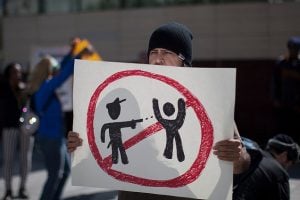The Supreme Court Makes It Even Easier For Cops To Shoot You
What we deem reasonable from the police has become absurd.

We live in a world where this is a controversial sign. (Photo by David McNew/Getty Images)
In an expected and unanimous opinion, the Supreme Court struck down the Ninth Circuit’s “provocation” rule, thus freeing the cops to shoot you even when they caused the violent confrontation in the first place.
The case is Los Angeles County v. Mendez. I explained the facts of the case before, when the Court granted cert, but they are grotesque enough that they bear repeating.

How To Maximize Productivity With Westlaw Precision With CoCounsel

Angel Mendez and wife Jennifer were homeless, living in a shack in a friend’s backyard. The police, searching for an armed parolee, came across their windowless shack while searching the friend’s premises. Without a warrant, or even so much as a knock and announcement that they were law enforcement, the police barged into the shack.
Police allege that Mendez reached for a BB gun, which he owned for shooting rats. The cops opened fire, unleashing 15 shots. Angel was shot multiple times; Jennifer — who was pregnant — was shot in the back.
At trial, a federal judge found that firing 15 shots at a family with a BB gun and shooting a pregnant lady in the back was a “reasonable” use of force, under the circumstances. But the Mendezes were awarded $4 million nonetheless because the police “provoked” the encounter with their unlawful search of the Mendez’s shack.
It’s that provocation rule, active only in the Ninth Circuit, that the Supreme Court struck down this morning. Under the Ninth Circuit’s approach, if you violate someone’s Fourth Amendment rights and then shoot up somebody’s backyard shack, that gunplay becomes an unreasonable use of force, even if it would have been “reasonable” but for the initial Fourth Amendment violation.
Sponsored

The Ethical use of Generative AI


How To Maximize Productivity With Westlaw Precision With CoCounsel


Mitigating M&A Cyber Risk: Pre- & Post-Acquisition Due Diligence

New Report - Are Small Firms Achieving Their Legal Tech Goals?
Everybody understands that approach, intuitively. If you take $20 out of my wallet without asking, it’s probably reasonable for me to slap you. But if I owe you the $20 bucks and have refused to pay you, maybe now my slap becomes unreasonable, given my prior violation of the social contract.
Of course, for the provocation rule to work, we have to think of the police as agents of the state who are responsible to the rest of us. Instead, the police are more like trained attack animals who can never be held accountable for their actions, and the Supreme Court would like to keep it that way. Here’s Justice Samuel Alito writing for a unanimous Court.
The basic problem with the provocation rule is that it fails to stop there. Instead, the rule provides a novel and unsupported path to liability in cases in which the use of force was reasonable. Specifically, it instructs courts to look back in time to see if there was a different Fourth Amendment violation that is somehow tied to the eventual use of force. That distinct violation, rather than the forceful seizure itself, may then serve as the foundation of the plaintiff ’s excessive force claim. Billington, supra, at 1190 (“The basis of liability for the subsequent use of force is the initial constitutional violation . . . ”).
This approach mistakenly conflates distinct Fourth Amendment claims. Contrary to this approach, the objective reasonableness analysis must be conducted separately for each search or seizure that is alleged to be unconstitutional. An excessive force claim is a claim that a law enforcement officer carried out an unreasonable seizure through a use of force that was not justified under the relevant circumstances. It is not a claim that an officer used reasonable force after committing a distinct Fourth Amendment violation such as an unreasonable entry.
You see his point. If the force was “unreasonable,” that’s one thing. But if the force was deemed reasonable (and remember, in this case the trial judge deemed the police’s use of force reasonable), then a prior constitutional violation should not change the reasonableness inquiry.
If it was reasonable for me to slap you, then it was reasonable for me to slap you regardless of who owes money.
Sponsored

New Report - Are Small Firms Achieving Their Legal Tech Goals?

Attention Buyer: Not All Legal AI Models Are Created Equal
I disagree with the Court because I don’t think the police should be allowed to essentially bait you into a confrontation.
Why is it that when it comes to evidence, we throw out everything that the police found during an illegal search, but when it comes to shooting your pregnant wife in the back, the illegal entry has no bearing on the reasonableness inquiry? We live in a world where a court might suppress evidence that I had a weapon, if the police violated my rights to find it, but can use the fact that the police saw a weapon near me as justification for killing me.
“Sorry sir, we didn’t obtain a warrant, so this gun probably won’t hold up in court, but since the weapon is in your grabbable area, I now fear for my life and I’m allowed to basically execute you right here, and no jury will convict me. Sucks to be you.”
Absent the provocation rule, we’re left with the core injustice of this case. Cops fired 15 bullets at a homeless man armed with a BB gun and his pregnant wife, and THAT was deemed a “reasonable” use of force at trial.
From where I sit, the whole damn system is unreasonable.
Los Angeles County v. Mendez [Supreme Court of the United States]
Earlier:







